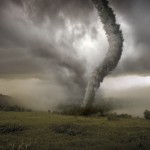A group of more than 80 scientists will travel the Great Plains over the next  few weeks in hopes of catching a tornado (or two) in action. They’re not just out for a cheap and dangerous thrill, however. They’re risking their lives trying to save lives in the future.
few weeks in hopes of catching a tornado (or two) in action. They’re not just out for a cheap and dangerous thrill, however. They’re risking their lives trying to save lives in the future.
The convoy of scientists, named VORTEX2, hope to find out what causes the killer twisters and how to give people earlier and more accurate warnings.
Tornado warnings average 13 minutes of lead time, and those come with a 70% false alarm rate, according to VORTEX2 planning documents. The researchers want to know whether warning times can be more accurate and whether warnings could be issued a half-hour or more before the storm strikes.
The funnels of death have wreaked havoc throughout the Midwest over the last several years — especially last year — racking up insurance losses and, worse, close to 60 lives. The Super Tuesday tornado outbreak on Feb. 5 and 6, 2008 spawned 82 tornadoes, killing 57 people and causing $955 million in claims, according to A.M. Best. According to the Insurance Information Institute, 2008 had an unheard-of 1,390 official torndoes.
2008 was not only the worst year for catastrophe losses from tornadoes and related weather events, but it also was the second worst year for the number of tornadoes. 2008 catastrophe losses from tornadoes and related events as reported by ISO/PCS totaled $10.5 billion from 29 events.
The 35-day research project was coordinated by the National Severe Storms Laboratory in Norman, Okla. and continues through June 13.
